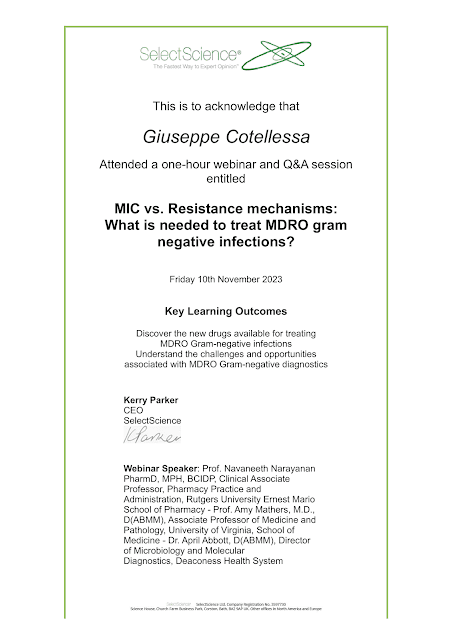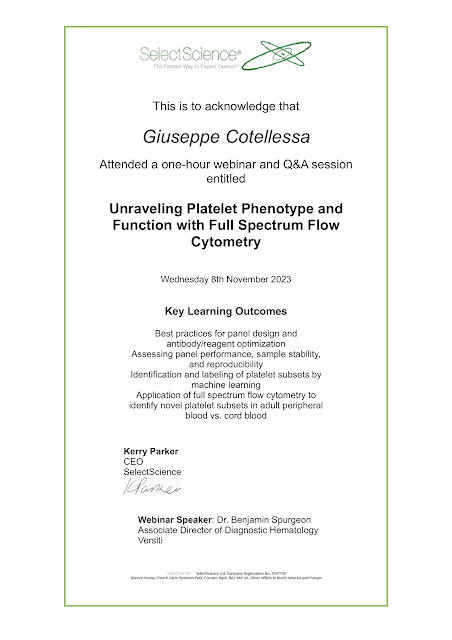This is to acknowledge that
Giuseppe Cotellessa
Attended a one-hour webinar and Q&A session entitled
"A new solution for analyzing high-dimensional data from ID7000™ Spectral Cell Analyzer on the Cloud" /
Questo per riconoscimento
Giuseppe Cotellessa
Ha partecipato ad un webinar di un'ora ed ad una sessione di domande e risposte dal titolo
"Una nuova soluzione per l'analisi di dati ad alta dimensionalità dall'analizzatore di cellule spettrali ID7000™ sul cloud" /#13/11/2023 bis
Dott. Giuseppe Cotellessa
Key learning objectives
- Review the current unmet needs for high parameter flow cytometry analysis
- Discover the main highlights and strengths of the SFA Platform
- Explore the available algorithms in the SFA Software
- Learn about the SFA user workflow as well as how it has been designed for efficiency
- Understand the differences between FlowSOM and BL-FlowSOM
- Explore the different SFA products available for purchase
Information
A new solution for analyzing high-dimensional data from the ID7000 Spectral Cell Analyzer on the Cloud
In this webinar, Keyon Taravati, Global Product Marketing Manager at Sony Biotechnology will demonstrate how the Spectral Flow Analysis (SFA) Life Sciences Cloud Platform allows users to efficiently analyze, manage and share data on Sony’s flagship ID7000™ Spectral Cell Analyzer. The SFA Platform promotes collaboration and revolutionizes high-parameter cellular data analysis. Designed for ease of use at every step, this first-of-its-kind, cloud-based technology from Sony imports data from the ID7000, and offers a wide array of processing functions, from conventional cellular analysis to more advanced dimensionality reduction, data cleaning, and clustering functions.
SFA is unique, in that the raw data output and analysis results from the ID7000 software can be directly imported and analyzed without any conversion to FCS files or down-sampling. In addition, this solution features BL-FlowSOM, a newly developed algorithm that improves upon FlowSOM, one of the well accepted clustering methods. Since each algorithm is pre-installed in the cloud environment, immediate analysis is possible, and results from the data analysis can be managed and shared among users.
ITALIANO
Obiettivi chiave di apprendimento
Esaminare le attuali esigenze insoddisfatte per l'analisi della citometria a flusso con parametri elevati
Scopri i principali punti di forza ed i punti di forza della Piattaforma SFA
Esplora gli algoritmi disponibili nel software SFA
Scopri il flusso di lavoro degli utenti SFA e come è stato progettato per l'efficienza
Comprendere le differenze tra FlowSOM e BL-FlowSOM
Esplora i diversi prodotti SFA disponibili per l'acquisto
Informazione
Una nuova soluzione per l'analisi di dati ad alta dimensionalità dall'analizzatore di cellule spettrali ID7000 sul cloud
In questo webinar, Keyon Taravati, Global Product Marketing Manager presso Sony Biotechnology, dimostrerà come la piattaforma cloud per l'analisi del flusso spettrale (SFA) Life Sciences consente agli utenti di analizzare, gestire e condividere in modo efficiente i dati sull'analizzatore di cellule spettrali ID7000™, fiore all'occhiello di Sony. La piattaforma SFA promuove la collaborazione e rivoluziona l'analisi dei dati cellulari ad alto parametro. Progettata per un utilizzo semplice in ogni fase, questa tecnologia unica nel suo genere basata su cloud di Sony importa dati dall'ID7000 e offre un'ampia gamma di funzioni di elaborazione, dall'analisi cellulare convenzionale alla riduzione dimensionale più avanzata, funzioni di pulizia e clustering.
SFA è unico, in quanto l'output dei dati grezzi e i risultati dell'analisi del software ID7000 possono essere importati ed analizzati direttamente senza alcuna conversione in file FCS o downsampling. Inoltre, questa soluzione presenta BL-FlowSOM, un algoritmo di nuova concezione che migliora FlowSOM, uno dei metodi di clustering più accettati. Poiché ogni algoritmo è preinstallato nell'ambiente cloud, è possibile un'analisi immediata ed i risultati dell'analisi dei dati possono essere gestiti e condivisi tra gli utenti.





